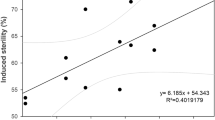Abstract
ONE of the problems that often arise with mosquitoes and other insects when radiation-induced dominant lethality (sterile-male technique) is used is that sterilized males cannot compete with untreated native males for matings with females. It is generally believed that the field trials of releases of radiation-sterilized males of Aedes aegypti in the United States were unsuccessful because radiation impaired vigour and competitive mating ability of released males1. In the case of Aedes aegypti, these conclusions were experimentally confirmed by Weidhaas and Schmidt2. Adults emerged from male pupae irradiated at 8,000 and 10,000 r inseminated only 4 and 0% of the females respectively when released into laboratory populations at a ratio of four treated males to one untreated.
This is a preview of subscription content, access via your institution
Access options
Subscribe to this journal
Receive 51 print issues and online access
$199.00 per year
only $3.90 per issue
Buy this article
- Purchase on SpringerLink
- Instant access to full article PDF
Prices may be subject to local taxes which are calculated during checkout
Similar content being viewed by others
References
Morlan, H. B., McCray, jun., E. M., and Kilpatrick, J. W., Mosq. News, 22, 295 (1962).
Weidhaas, D. E., and Schmidt, C. H., Mosq. News, 23, 32 (1963).
Thoday, J. M., and Read, J., Nature, 160, 608 (1947).
Hollander, A., Baker, G., and Anderson, H., Cold Spring Harb. Symp. Quant. Biol., 16, 315 (1951).
Baldwin, W. F., and Chance, G. D., IAEA SM/138/1 (1970).
Hooper, G. H. S., J. econ. Ent., 64, 1364 (1972).
Author information
Authors and Affiliations
Rights and permissions
About this article
Cite this article
HALLINAN, E., RAI, K. Radiation Sterilization of Aedes aegypti in Nitrogen and Implications for Sterile Male Technique. Nature 244, 368–369 (1973). https://doi.org/10.1038/244368a0
Received:
Issue Date:
DOI: https://doi.org/10.1038/244368a0



